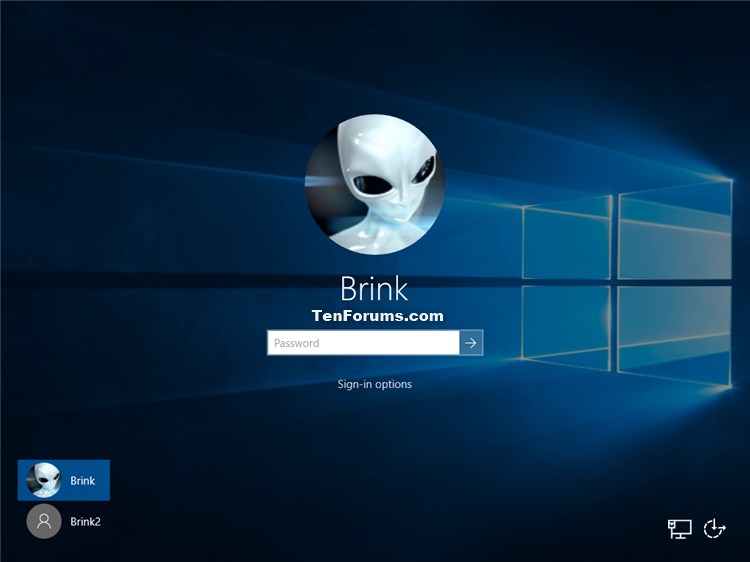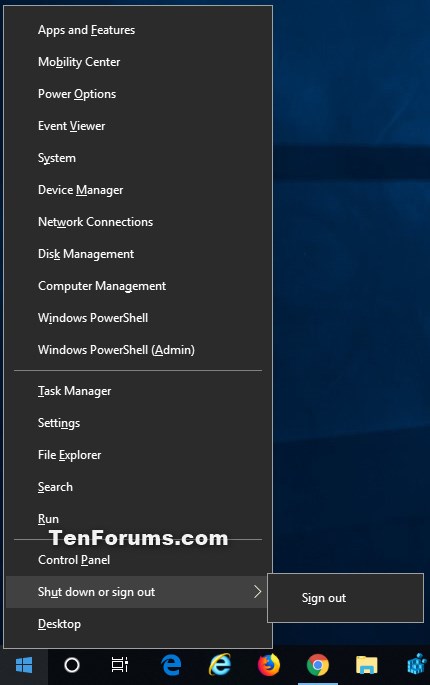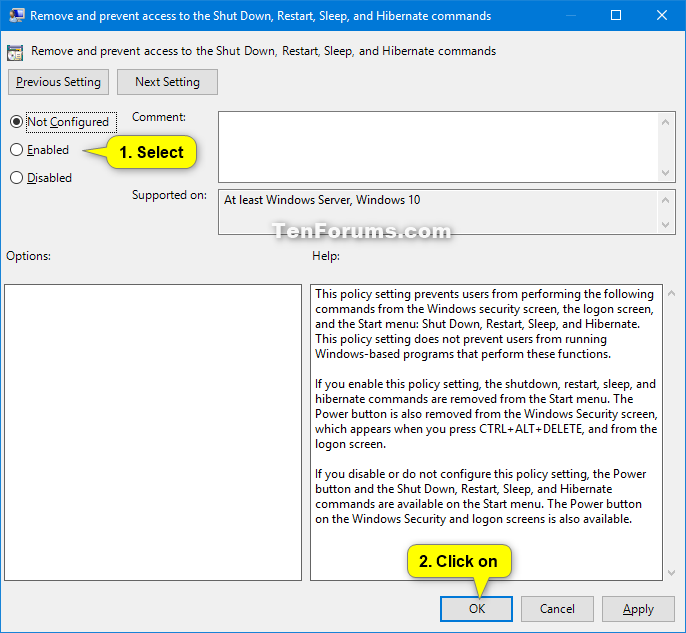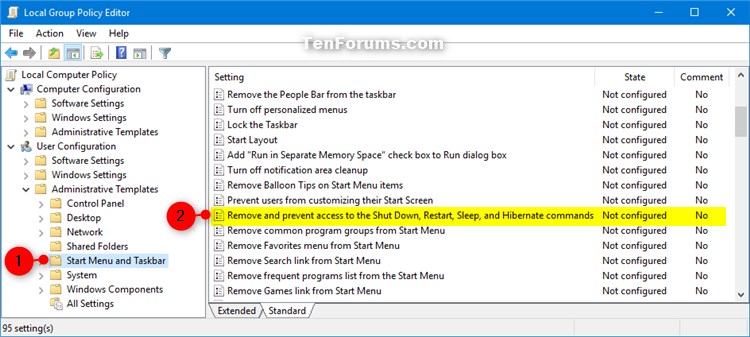How to Enable or Disable Shut Down, Restart, Sleep, and Hibernate in Power Menu in Windows 10
The Power menu in Windows 10 can allow users to sleep, hibernate, shut down, or restart the PC without having to sign in to Windows.
This tutorial will show you how to enable or disable Shut Down, Restart, Sleep, and Hibernate in the Power menu for specific or all users in Windows 10.
You must be signed in as an administrator to enable or disable Shut Down, Restart, Sleep, and Hibernate in Power Menu.
This does not affect the Alt+F4 Shut Down Windows dialog, and does not prevent users from using other methods to sleep, hibernate, shut down, or restart.
Contents
- Option One: Enable or Disable Shut Down, Restart, Sleep, and Hibernate in Power Menu for All Users in Local Group Policy Editor
- Option Two: Enable or Disable Shut Down, Restart, Sleep, and Hibernate in Power Menu for Specific Users in Local Group Policy Editor
- Option Three: Enable or Disable Shut Down, Restart, Sleep, and Hibernate in Power Menu for All Users using a REG file
EXAMPLE: Shut Down, Restart, Sleep, and Hibernate disabled in Power menu
Ctrl+Alt+Del
Sign-in screen
Start menu
Win+X Quick Link menu
The Local Group Policy Editor is only available in the Windows 10 Pro, Enterprise, and Education editions.
All editions can use Option Three below.
1 Open the Local Group Policy Editor.
2 In the left pane of the Local Group Policy Editor, click/tap on to expand Computer Configuration, Administrative Templates, and Start Menu and Taskbar. (see screenshot below)
3 In the right pane of Start Menu and Taskbar, double click/tap on the Remove and prevent access to the Shut Down, Restart, Sleep, and Hibernate commands policy to edit it. (see screenshot above)
4 Do step 5 (enable) or step 6 (disable) below for what you would like to do.
A) Select (dot) Not Configured or Disabled, click/tap on OK, and go to step 7 below. (see screenshot below)
Not Configured is the default setting.
7 When finished, you can close the Local Group Policy Editor if you like.
The Local Group Policy Editor is only available in the Windows 10 Pro, Enterprise, and Education editions.
All editions can use Option Three below.
1 Open the all users, specific users or groups, or all users except administrators Local Group Policy Editor for how you want this policy applied.
2 In the left pane of the Local Group Policy Editor, click/tap on to expand User Configuration, Administrative Templates, and Start Menu and Taskbar. (see screenshot below)
3 In the right pane of Start Menu and Taskbar, double click/tap on the Remove and prevent access to the Shut Down, Restart, Sleep, and Hibernate commands policy to edit it. (see screenshot above)
4 Do step 5 (enable) or step 6 (disable) below for what you would like to do.
A) Select (dot) either Not Configured or Disabled, click/tap on OK, and go to step 7 below. (see screenshot below)
Not Configured is the default setting.
7 When finished, you can close the Local Group Policy Editor if you like.
The downloadable .reg files below will add and modify the DWORD value in the registry keys below.
HKEY_CURRENT_USER\Software\Microsoft\Windows\CurrentVersion\Policies\Explorer
HKEY_LOCAL_MACHINE\SOFTWARE\Microsoft\Windows\CurrentVersion\Policies\Explorer
HidePowerOptions DWORD
(delete) = Enable
1 = Disable
1 Do step 2 (enable) or step 3 (disable) below for what you would like to do.
This is the default setting.
A) Click/tap on the Download button below to download the file below, and go to step 4 below.
Enable_Shut-Down_Restart_Sleep_Hibernate_in_Power-Menu.reg
Download
A) Click/tap on the Download button below to download the file below, and go to step 4 below.
Disable_Shut-Down_Restart_Sleep_Hibernate_in_Power-Menu.reg
Download
4 Save the .reg file to your desktop.
5 Double click/tap on the downloaded .reg file to merge it.
6 When prompted, click/tap on Run, Yes (UAC), Yes, and OK to approve the merge.
7 You can now delete the downloaded .reg file if you like.
That's it,
Shawn
Related Tutorials
- How to Add or Remove Power Menu Icon on Sign-in Screen in Windows 10
- How to Add or Remove Hibernate from Power menu in Windows 10
- How to Add or Remove Sleep from Power menu in Windows 10
- How to Hibernate the Computer in Windows 10
- How to Restart the Computer in Windows 10
- How to Shut Down the Computer in Windows 10
- How to Put Your Computer to Sleep in Windows 10
- How to Change Computer Sleep After Time in Windows 10
- How to Add or Remove 'Enable forced button/lid shutdown' from Power Options in Windows
- How to Add or Remove 'Sleep after' from Power Options in Windows
- How to Add or Remove 'Hibernate after' from Power Options in Windows
- How to Allow or Prevent Users and Groups to Shut down System in Windows 10
- How to Automatically Shut Down Computer at Scheduled Time in Windows 10
Disable Shut Down, Restart, Sleep, and Hibernate in Windows 10

Disable Shut Down, Restart, Sleep, and Hibernate in Windows 10
How to Enable or Disable Shut Down, Restart, Sleep, and Hibernate in Power Menu in Windows 10Published by Shawn BrinkCategory: General Tips
19 Sep 2020
Tutorial Categories


Related Discussions









